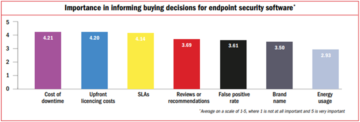 An ESET report claims that the channel may be overlooking the total cost of ownership (TCO) when it comes to choosing software.
An ESET report claims that the channel may be overlooking the total cost of ownership (TCO) when it comes to choosing software.
According to the report The True Cost of Security less than half of the senior decision-makers factoring it into purchasing decisions.
Alongside the research report, ESET has also produced a calculator that lets businesses discover the total cost of owning their current cybersecurity solution.
For the report, ESET quizzed more than 150 decision-makers at channel firms in April 2021 to explore their view of the threat landscape and the role that total cost of ownership plays in technology deployments.
Total cost of ownership is a measure of how much it will cost an organisation to buy and use a piece of technology over its entire lifetime, including all ongoing expenses in addition to the initial purchase. TCO also considers energy usage and performance efficiencies, the cost of downtime, maintenance and, ultimately, upgrade or replacement.
Considering TCO has become increasingly important in technology procurement, with ESET’s research finding that it is a significant factor in two-thirds of conversations between channel firms and clients about purchasing end-user computing devices (69 per cent) and computing infrastructure (65 percent).
 However, when it comes to purchasing software, minimising the cost of ownership is often overlooked. Only 42 percent of channel chiefs report that their clients account for TCO when discussing security programs — a figure which falls to 27 per cent for enterprise software, and just 11 per cent for commodity software.
However, when it comes to purchasing software, minimising the cost of ownership is often overlooked. Only 42 percent of channel chiefs report that their clients account for TCO when discussing security programs — a figure which falls to 27 per cent for enterprise software, and just 11 per cent for commodity software.
In The True Cost of Security, ESET investigated the top considerations that inform buying decisions for endpoint security software. The report found that the cost of downtime is seen as the most critical factor by channel decision-makers, achieving a score of 4.21 out of 5.
While this could point to an awareness of the total cost of ownership, another element of the software’s overall cost – energy usage – ranked comfortably bottom of the pile, with just 2.9 out of 5. Minimising both downtime and the level of energy consumption reduces the total cost of ownership, highlighting the benefits of software with a low system impact.
A close second to the cost of downtime in informing buying decisions was upfront licensing costs – which received a 4.20 average. With initial investment still factoring so highly into buying choices, organisations may be losing money in the long term.
Head of UK ESET Channel Marketing Steve Connolly said: “Security software purchase decisions are – quite rightly – made on high detection rates, low false positives, good functionality, reporting capability and a combination of comparatives websites, supported by experience and peer research. However, if you factor in the potential total cost of ownership, especially with large numbers of endpoints, system impact should also be a key consideration.”





